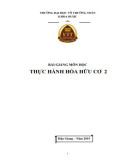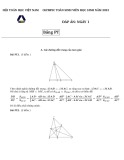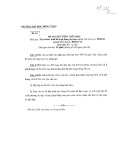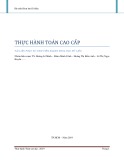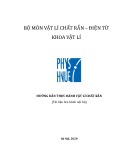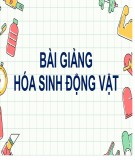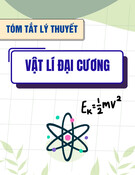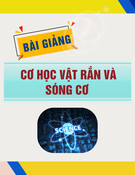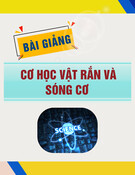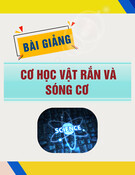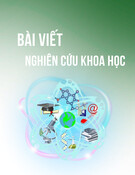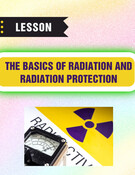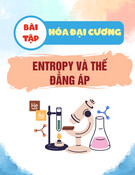TÀI LIỆU TẬP HUẤN GIẢNG VIÊN DẠY CHUYÊN NGÀNH BẰNG TIẾNG ANH
KHOA: VẬT LÍ
MỤC LỤC
BÀI 1: KINH NGHIỆM DẠY TIẾNG ANH CHUYÊN NGÀNH ................... 3
BÀI 2: XÂY DỰNG BÀI GIẢNG VẬT LÍ (LÍ THUYẾT) BẰNG TIẾNG
ANH ................................................................................................................. 16
BÀI 3: XÂY DỰNG NỘI DUNG BÀI GIẢNG VẬT LÍ (THỰC HÀNH)
BẰNG TIẾNG ANH ........................................................................................ 33
BÀI 4: XÂY DỰNG NỘI DUNG BÀI GIẢNG VẬT LÍ RÈN LUYỆN NGHỀ
2 Tài liệu tập huấn giảng viên dạy chuyên ngành bằng tiếng Anh
BẰNG TIẾNG ANH ........................................................................................ 47
BÀI 1: KINH NGHIỆM DẠY TIẾNG ANH CHUYÊN NGÀNH
I. Giới thiệu hoạt động tập huấn
Việt Nam là một đất nước giầu tiềm năng về phát triển kinh tế xã hội.
Những thế mạnh về truyền thống hiếu học, khả năng tư duy sáng tạo, tình
hình chính trị, xã hội ổn định cộng với chính sách mở cửa của Nhà nước…đã thu hút được sự quan tâm đặc biệt của các nhà đầu tư nước
ngoài. Chính những chính sách đầu tư vào các hoạt động sản xuất và
thương mại này đã đóng vai trò to lớn trong sự phát triển xã hội như ngày
nay. Tuy nhiên, nguồn nhân lực chất lượng cao của chúng ta đã chưa đáp ứng được với nhu cầu thực tiễn cho nên chúng ta đã mất đi một nguồn lợi
đáng kể. Một trong những nguyên nhân của tình trạng này là do trình độ
ngoại ngữ của người lao động Việt Nam còn rất kém, tạo rào cản lớn trong
việc tiếp thu công nghệ hiện đại. Nắm bắt được thực trạng trên, trong
những năm gầm đây, Nhà nước đã có những chính sách đặc biệt nhằm
từng bước nâng cao năng lực ngoại ngữ của giới trẻ. Chính sách này được
thể hiện qua “dự án Ngoại Ngữ 2020” trong đó việc giảng dạy các môn
khoa học tự nhiên bằng tiếng Anh là một trong những nội dung quan
trọng.
Trên thực tế, bộ Giáo dục đã tổ chức nhiều khóa tập huấn dạy vật lí bằng
tiếng Anh cho các giáo viên vật lí. Tuy nhiên, công việc này gặp không ít khó khăn vì các giáo viên này vốn là các giáo viên Vật lí thuần túy, trình
độ ngoại ngữ còn hạn chế. Năm 2014, lần đầu tiên khoa Vật lí Đại học Sư
phạm Hà Nội tuyển sinh lớp đào tạo giáo viên dạy và học Vật lí bằng tiếng
Anh. Đây là khóa sinh viên được kỳ vọng sẽ trở thành các giáo viên dạy Vật lí giỏi tiếng Anh và có khả năng dạy Vật lí bằng tiếng Anh một cách chuyên nghiệp.
Theo chương trình đào tạo, các sinh viên theo học lớp học Vật lí bằng tiếng Anh phải học tất cả các môn Vật lí và Toán bằng tiếng Anh. Để chuẩn bị cho việc tiếp nhận các kiến thức bằng tiếng Anh, trong học kỳ
đầu, sinh viên được bồi dưỡng tiếng Anh một cách khá bài bản. Sinh viên
3 Tài liệu tập huấn giảng viên dạy chuyên ngành bằng tiếng Anh
được học 3 học phần tiếng Anh cơ bản và nâng cao (do khoa Tiếng Anh
đảm nhiệm) nhằm luyện các kỹ năng nghe nói đọc viết thông thường và 1
học phần tiếng Anh chuyên ngành Vật lí (do khoa Vật lí đảm nhiệm) nhằm nâng cao kỹ năng sử dụng tiếng Anh trong việc diễn đạt các nội
dung vật lí theo đúng chuẩn văn phong khoa học đồng thời cung cấp từ
vựng chuyên ngành và kỹ năng giao tiếp trong trường học để chuẩn bị cho nhiệm vụ học tập các môn Toán và Vật lí bằng tiếng Anh.
Học phần tiếng Anh cho Vật lí đã được thực hiện một học kỳ, bài viết này nhằm
chia sẻ những kinh nghiệm trong dạy và học tiếng Anh chuyên ngành. Nội dung cụ thể sẽ được trình bày ở mục sau.
II. Các tài liệu tập huấn
2.1 Chuẩn bị tài liệu học Tiếng Anh cho Vật lí (English for Physics) hướng tới đối tượng sinh viên Vật
lí học bằng tiếng Anh. Các bài học được soạn theo các chủ đề vật lí. Mỗi chủ đề
đều nhằm rèn các kỹ năng cơ bản cần thiết trong dạy và học vật lí như: Kỹ năng
xây dựng khái niệm (defining), kỹ năng mô tả (describing), kỹ năng xây dựng
giả thuyết (hypothesizing), kỹ năng so sánh (comparing), kỹ năng xây dụng thí
nghiệm (experimenting)… Thông thường, mỗi bài học được chia thành các
phần bao gồm: 1. bài đọc ngắn (short reading) có nội dung liên quan đến
một chủ đề thuộc Vật lí trong đó tác giả có sử các kỹ năng như trình bày
ở trên (experimenting, describing, comparing, hypothesizing, defining…). Từ
bài đọc này, các mẫu câu nhằm diễn đạt các nội dung tư duy Vật lí được
liệt kê dưới dạng công thức để sinh viên thực hành viết (nói) để diễn đạt
những nội dung tương tự. 2. Bài đọc hiểu và từ vựng (Reading and vocabulary comprehension): phần này được soạn dưới dạng các bài trắc
nghiệm điền từ vào chỗ trống hoặc thay thế từ bằng từ có nghĩa tương
đương hoặc viết lại câu... 3. Nghe hiểu (listening comprehension) và nói:
Sinh viên được nghe người bản xứ đọc một đoạn dài. Sau mỗi đoạn có những câu hỏi hoặc những nhận định mang tính chủ quan. Sinh viên
được chia thành từng nhóm để thảo luận và đưa ra quan điểm của mình. Các nhóm có thể có quan điểm khác nhau. Do đó, từng nhóm phải tranh luận để bảo vệ quan điểm của mình.
4 Tài liệu tập huấn giảng viên dạy chuyên ngành bằng tiếng Anh
2.2 Tổ chức lớp học, xây dựng các nhóm học tập
Một đặc điểm của lớp học này là các sinh viên có trình độ ngoại ngữ khá
chênh lệch. Một số em thi đầu vào khối A1 số còn lại thuộc khối A, một số em học ở các thành phố lớn, một số em học ở quê chính là nguyên
nhân dẫn đến chất lượng đầu vào khác nhau. Đây vừa là khó khăn nhưng
cũng là thuận lợi vì có thể tận dụng khả năng của các sinh viên giỏi giúp các sinh viên còn chưa giỏi. Trên tinh thần lấy hoạt động của học sinh là
chính, lớp học được chia làm nhiều nhóm, mỗi nhóm có 4 sinh viên sao
cho mỗi nhóm đều có những sinh viên giỏi đóng vai trò dẫn dắt. Các
nhóm học tập này sẽ thường xuyên trao đổi nội dung học tập ở nhà cũng như trên lớp học. Khi có bài tập, hoặc câu hỏi gì, các thành viên trong
nhóm phải trao đổi với nhau bằng tiếng Anh dưới sự giám sát của giáo
viên. Với cách học tập như trên, tất cả các sinh viên đều phải làm việc và
đều có cơ hội nói tiếng Anh trong mỗi giời học.
2.3 Xây dựng kịch bản dạy học cho mỗi bài học
Trước khi vào bài học chính, sinh viên có khoảng 15 phút khởi động
(warm up) bằng bài nói tự do (free talking) về một chủ đề ngẫu hứng nào
đó. Sau phần warm up, sinh viên bắt đầu làm việc theo nhóm. Ví dụ dưới
là một bài học về kỹ năng xây dựng một khái nệm vật lí (Defining) với
chủ đề năng lượng (Energy).
Short Reading: Sinh viên sẽ đọc bài đọc ngắn về chủ đề năng lượng.
Trong bài đọc, có rất nhiều khái niệm về năng lượng được đề cập tới.
Sinh viên phải khái quát thành các cấu trúc câu để dựa vào đó có thể diễn
tả các khái niêm vật lí khác. Sinh viên hoạt động theo nhóm để giải quyết các yêu cầu của giáo viên được ghi ở cuối bài đọc.
Read the following passage to find definitions for as many types of energy as you can.
The Many Forms of Energy
Energy is the ability to do work. When a hammer strikes a nail, it exerts a force on the nail that causes it to move. The movement of the hammer has the ability to do work and therefore has a form of energy that we call
kinetic energy. Kinetic energy is the energy of motion.
5 Tài liệu tập huấn giảng viên dạy chuyên ngành bằng tiếng Anh
An object may have energy not only because of its motion but also
because of its position or shape. For example, when a watch spring is
wound, it is storing energy. When this energy release, it will do the work of moving the hands of the watch. This form of energy is called potential
energy. Potential energy is stored energy. Water in a dam is another
example of potential energy.
There are many types of kinetic and potential energy, including
chemical, thermal, mechanical, electrical, and nuclear energy. Chemical
energy is potential energy that is stored in gasoline, food, and oil. Just as the watch spring needs to be released to do the work of moving the
hands, the energy stored in food molecules needs to be released by
enzymes or substances in the body, and the energy stored in gasoline
must be released by the spark plug to do its work of propelling the car
forward. Thermal energy may be defined as the kinetic energy of
molecules. When a substance is heated, the molecules move faster,
which causes that substance to feel hot? Mechanical energy is energy
related to the movement of objects. Electric energy is energy that is
produced by electric charges. Nuclear energy is the energy that is stored
in the nucleus of certain kinds of atoms, like uranium.
Understanding the reading
Task 1. Read out loud the passage
Task 2. Underline the sentences that describe an energy concept. How
many types of energy are there in the passage? What are they?
Task 3. Lear the ways that author defines new concept.
NOTE: When defining, remember the following:
Definitions require the present simple tense and the verb to be.
The definite article, the, is usually not used with the term being defined
because definitions are general statements. For example, we would define a giraffe (in general), not the giraffe (a specific giraffe).
6 Tài liệu tập huấn giảng viên dạy chuyên ngành bằng tiếng Anh
Sentence Patterns
Analyzing Definitions: In each of the following definitions,
underline the general class once, and the specific
1. Helium is an inert gas that is light and nonflammable.
2. Protozoa are one -celled organisms.
3. A machine is a device that transforms energy from one
characteristic(s) twice.
4. The cerebrum is the part of the brain that is the center of
form to another.
5. An insulator is a substance that does not conduct heat or electricity.
6. Fog is a cloud that forms on the ground.
7. Ecology is the study of the environment.
8. A satellite is a celestial body that orbits another celestial body.
reasoning.
7 Tài liệu tập huấn giảng viên dạy chuyên ngành bằng tiếng Anh
Relative Clauses
A clause is a part of a sentence that contains a noun and a verb. A
relative clause is one that begins with which, that, where, or who, which and that are most commonly used in science definitions; who is used
when referring to people. Science definitions often include relative
clauses containing the characteristics that distinguish an item from others in the class.
Using Relative Clauses: Combine each of the following pairs of sentences
1.
to produce a one sentence definition with a relative clause.
Protons are positively charged particles. They are contained in the
nucleus of an atom.
Protons are positively charged particles that are contained in the
2.
nucleus of an atom.
A black hole is an area in space. It has a gravitational pull so
3. Marine biologists are scientists. They study animals and plants that
powerful that nothing, not even light, can escape.
4.
live in the sea,
The stratosphere is a portion of the atmosphere. It is over seven
5.
miles high.
Insulin is used in the treatment of diabetes. It is a hormone
6.
produced by the pancreas.
The most abundant form of life on earth are bacteria. They are
7.
simple forms of plant life.
Oxidation is a chemical reaction. It involves the loss of one or
8.
more electrons by an atom or ion
Nitrogen makes up 80 percent of the air. It is a colorless, odorless
gas.
Creating Definitions: A good way to see if a definition is complete is to reverse it. For example, if we reverse an elephant
is an animal, we get an animal is an elephant, and it is obvious that
8 Tài liệu tập huấn giảng viên dạy chuyên ngành bằng tiếng Anh
the definition is inadequate. Formulate a definition for each
of the following words and test each on e by reversing it. If
you need help, use a dictionary
Alternative current Circuit Led Resistor
Amperemeter Diode Lens Ruler
Amplify circuit Direct current Mirror Speed
Caliper Electric wire Motor Velocity
Capacitor Force Multimeter Voltage
Ohmmeter Voltmeter
Speaking: Sinh viên được cung cấp một số danh từ thường thường
gặp, họ có thể sử dụng từ điển nếu họ muốn. Tiếp theo các nhóm
sẽ thảo luận với nhau để tìm cách định nghĩa các từ đó bằng tiếng Anh. Cuối cùng, các nhóm sẽ kiểm tra chéo lên nhau bằng cách
nhóm này đọc khái niệm, nhóm kia phải nói xem cái đó là cái gì.
Quá trình được thực hiện đến khi nào hai bên hiểu đúng ý của
nhau.
Separate class in to 4 groups. Group 1 choses five words in the
table above and define them. The others groups have to name the
works.
Example:
Group 1 says: This is an electric tool that used to
measure electric current.
Answer: this is an amperemeter.
Do the same activities with the other groups
Listening:
Bài nghe được gửi trước cho sinh viên nghiên cứu ở nhà. Trước khi nghe, sinh viên được cung cấp các từ được nhắc nhiều trong
bài nghe. Sinh viên sẽ sử dụng từ điển nói (talking dictionary)
9 Tài liệu tập huấn giảng viên dạy chuyên ngành bằng tiếng Anh
chuẩn để nghe những từ này. Phần này sinh viên phải học ở nhà
trước khi lên lớp
Listen and answer the questions.
Note: Before listening, look up talking dictionary and try to study
the new words
Tape 1
New works
Ability, brain, categories, change, chemical, comfortable, contracts,
energy, forms, heat, illuminates, kinetic, lights, motion, muscles, object,
planet, position, potential, scientists, signals, sound, surface, transmits
Tape 2
New works
Amount, assuming, calculate, contains, dependent, directly, equation,
explore, important, mass, object, pretty, proportional, relationship, rest,
speed, twice, upon, variables, variables, velocity
Tape 3
New works
Absorbers, arrangement, automobiles, balls, beams, bonds, broken,
buildings, burned, catches, chemicals, construct, contain, contains,
couple, devices, distance, existing, explored, force, gasoline, hold,
individual, likewise, look, metal, mouse, obviously, original, perhaps,
released, resting, result, resumes, shape, shock, something, specifically,
spring, stored, system, tires, trap, tripped, work, wrecking.
Tape 4
New works
Alone, bicycle, bike, contract, converted, dependent, discuss, exist, food, formerly, hill, order, relationship, ride, roll, tightly
10 Tài liệu tập huấn giảng viên dạy chuyên ngành bằng tiếng Anh
Listen and answer the questions: Nội dung này được cung cấp tại lớp học (sinh viên không được biết trước câu hỏi ở nhà). Các nhóm sẽ cùng thảo luận với nhau bằng tiếng Anh dưới sự giám sát của giáo viên để
phán đoán câu trả lời. Tiếp theo, sinh viên sẽ được nghe lại bài nghe,
từng nhóm sẽ trả lời câu hỏi và giả thích tại sao họ lại lựa chọn câu trả lời như vậy. Các nhóm sẽ cùng góp ý với nhau về các câu trả lời của
từng nhóm
Tape 1
1. What is the best title of the lecture?
A) How to change energy from one form into another
B) Relationship in Different Energy Types
C) Energy illuminates the lights in our homes and moves cars down the road
D) The different forms of energy
2. Energy warms surface of
A) The earth
B) The stars
C) The solar
D) The streams
E) The sea
3. According to lecture, which of the following is not true?
A) Energy can do work
B) Energy moves the cars from our home to road
C) Energy blows the wind through our hair
D) Energy illuminates the lights in our homes
4. What have scientists learned
A) The way to save energy
B) The way to change energy to the light
11 Tài liệu tập huấn giảng viên dạy chuyên ngành bằng tiếng Anh
C) The way to change energy from one form into another
D) How to use energy right way to make our lives more
comfortable
5. According to lecture, how many forms of energy existing in different forms are there?
A) 2
B) 3
C) 4
D) 5
Tape 2
1. When does kinetic energy occur?
A) When an object is at rest
B) When an object is in motion
C) When an object receives heat
D) When an object releases energy
2. How many variables do the amount of kinetic energy of an object
depend on? What are there?
A) 1
B) 2
C) 3
D) 4
3. How do you calculate kinetic energy?
4. Which of the following is true?
A) Smaller change in speed, larger changes in kinetic energy
B) Smaller change in mass, larger changes in kinetic energy
12 Tài liệu tập huấn giảng viên dạy chuyên ngành bằng tiếng Anh
C) Kinetic energy is directly proportional to the mass of the object or the square of its speed
D) If a car moves twice as fast as another, it will contain tow
times as much kinetic energy
Tape 3
1. What is lecture about?
A) Explore kinetic energy
B) Explore potential energy
C) How to store energy
D) How to do work on an object
2. According to the lecture, what type of energy is stored in an object when you finish doing work on it?
A) Kinetic energy
B) Potential energy
C) Heat energy
D) Mechanical energy
3. According to the lecture, when is the trap-stored potential energy?
A) The spring does work
B) The trap catches a mouse
C) The lever is in the set position
D) The trap is tripped
4. Apart from the trap, how many devices are there mentioned in the lecture can be store potential energy?
A) 1
B) 2
C) 3
D) 4
13 Tài liệu tập huấn giảng viên dạy chuyên ngành bằng tiếng Anh
5. How is potential energy stored in chemicals
A) The chemical potential energy is related to the arrangement of
the chemicals
B) Reaction between to chemical elements
C) The energy existing within a chemical system
D) The different chemicals are mixed together
6. What happen when gasoline is burned?
A) The bonds within the gasoline are broken resulting in releasing
potential energy
B) The bonds within the gasoline are broken resulting in storing
potential energy
C) To provide food for our bodies
D) To break down food chemicals
Tape 4
1. What is the best title of the lecture?
A) The Relationship between Kinetic and Potential Energy
B) Difference between Kinetic and Potential Energy
C) Difference ways to store energy
D) To convert energy from food into kinetic energy
2. According to lecture, why do we have a difficulty to discuss kinetic
or potential energy alone?
A) Because they are quite different
B) Because they are so tightly related and even dependent upon each other
C) Because they do not happen at the same time
D) Because they do not happen at the same position
3. How does the way any kinetic energy exist?
14 Tài liệu tập huấn giảng viên dạy chuyên ngành bằng tiếng Anh
A) An object is stored energy
B) It is released from potential energy
C) The kinetic energy is used store potential energy in any system
D) To store potential energy in food to contract muscle
4. The person rides the bike to the top of a hill. What type energy is
formed when he (or she) stays in the top of a hill
A) The energy is used to roll the bike down the hill
B) The potential energy
C) The kinetic energy of motion
15 Tài liệu tập huấn giảng viên dạy chuyên ngành bằng tiếng Anh
D) The heat energy
BÀI 2: XÂY DỰNG BÀI GIẢNG VẬT LÍ (LÍ THUYẾT) BẰNG TIẾNG
ANH
1. Giới thiệu
Dạy học Vật lí là một trong những phần quan trọng nhất, quyết định
chất lượng giáo viên Vật lí được đào tạo ở các trường Đại học Sư phạm.
Các học phần Vật lí (lí thuyết) vừa có vai trò củng cố sâu sắc thêm kiến
thức Vật lí cần cho người học khi dạy ở trường phổ thông, vừa có vai trò
hình thành và xây dựng nội dung kiến thức mới cần thiết trong cả giảng dạy và nghiên cứu.
Gần đây, việc đào tạo chương trình cử nhân bằng tiếng nước ngoài
đã được đưa vào thực hiện tại một số trường đại học trong nước, đáp ứng
phần nào nhu cầu du học tại chỗ. Từ năm 2014, Trường ĐHSP HN đã tổ
chức tuyển sinh hệ Cử nhân Sư phạm Vật lí dạy bằng tiếng Anh khóa
đầu tiên. Trên cơ sở đó, báo cáo này đưa ra một số điểm lưu ý trong việc
xây dựng một bài giảng lí thuyết Vật lí bằng tiếng Anh ở Khoa Vật lí,
Đại học Sư phạm Hà Nội.
Các vấn đề được trình bày trong báo cáo: + Chuẩn bị nội dung (kiến thức);
+ Các bước xây dựng một bài giảng.
1.1 Chuẩn bị nội dung kiến thức
+ Chuẩn bị nội dung kiến thức Vật lí (bằng tiếng Việt): các giảng
viên dạy lí thuyết hệ cử nhân Sư phạm Vật lí bằng tiếng Anh (nên) là
những giảng viên có kinh nghiệm giảng dạy nhiều năm, do đó đã nắm
vững nội dung kiến thức Vật lí. Trong trường hợp các trợ giảng lần đầu, giảng viên cần tham khảo các giáo trình Vật lí bằng tiếng Việt trước để nắm vững nội dung cần thiết. Trong phần này cần xác định được phần
16 Tài liệu tập huấn giảng viên dạy chuyên ngành bằng tiếng Anh
kiến thức nào sẽ được kiểm tra, củng cố trong bài, chú ý đến các khối kiến thức Vật lí phổ thông, khối kiến thức hay dùng trong cuộc sống; xác định phần kiến thức mới trong bài. Hai phần kiến thức này sẽ hỗ trợ nhau nâng cao hiệu quả của bài giảng.
+ Chuẩn bị nội dung kiến thức Vật lí (bằng tiếng Anh): việc chuẩn
bị nội dung kiến thức bằng tiếng Anh có thể tiến hành bằng cách dịch tài liệu tiếng việt. Tuy nhiên không nên làm như vậy, mà nên tham khảo
trực tiếp giáo trình bằng tiếng Anh do các trường đại học lớn trên thế
giới biên soạn. Thông thường khi tham khảo các tài liệu này, một số kiến thức Vật lí trong giáo trình tiếng Việt cũng được cập nhật, chuẩn hóa lại.
Cách tốt nhất là xem các bài giảng của các Giáo sư trên mạng, tham gia
các lớp học mở trực tuyến như trong một số trang mạng ở dưới đây: http://physics.princeton.edu/strings2014/Talk_titles.shtml http://www.perimeterinstitute.ca/video-library http://web.mit.edu/redingtn/www/netadv/ http://www.aspenphys.org/public/video.html http://video.ias.edu/ http://scgp.stonybrook.edu/multimedia/videos http://ocw.mit.edu/courses/physics/ http://www.ictp.tv/diploma/ http://www.physics.oregonstate.edu/~rubin/Books/eBookWorking/
VideoLecs/index.html
http://www.physics.harvard.edu/about/loeb.html http://www.physics.harvard.edu/about/MonColloqArch.html http://www.gutenberg.org/wiki/Main_Page http://www.ctc.cam.ac.uk/activities/adsgrav2014/?page=program http://users.ictp.it/~video/Conferences/2577/2577.htm
1.2 Các bước xây dựng một bài lí thuyết Vật lí
+ Xác định mục đích, yêu cầu của bài giảng: Đọc kỹ giáo trình (xem mục Chuẩn bị nội dung kiến thức ở trên), kết hợp
với các tài liệu liên quan để tìm hiểu kĩ nội dung của của bài học và cái đích cần đạt tới của bài. Sau đó giảng viên xác định cái đích cần đạt tới (khi giảng xong, học viên thu nhận được cái gì) về cả 3 mặt kiến thức, kỹ
năng và tình cảm-thái độ. Qua đó giảng viên có thể định ra các yêu cầu trong quá trình giảng dạy của mình để đạt cái đích đã đề ra ở trên (giảng như thế nào).
+ Lựa chọn những kiến thức cơ bản, trọng tâm để đưa vào các
17 Tài liệu tập huấn giảng viên dạy chuyên ngành bằng tiếng Anh
slide:
Đây là bước quan trọng thể hiện toàn bộ nội dung của bài giảng. Các nội
dung đưa vào các slide phải thật sự chắt lọc từ những kiến thức cơ bản của từng chương, mục, tiết, đoạn. Dung lượng thông tin chứa đựng trong
một slide không nên dài dòng, đòi hỏi giảng viên phải có tư duy tổng
hợp, khái quát để có thể chọn lựa, chắt lọc kiến thức cơ bản nhất đưa vào các slide. Tuy nhiên, cũng cần tương đối chi tiết để khi sinh viên có thể
hiểu và nhớ lại được những gì đã học khi xem lại handout bài giảng
(quan trọng đối với sinh viên khi nghe giảng bằng tiếng Anh).
+ Thu thập bổ sung tài liệu liên quan đến nội dung, xây dựng kho
tư liệu để làm phong phú bài giảng:
Thu thập chính từ Internet: ví dụ các trang ở mục 2.1.1. Lưu ý các kĩ
năng khi search với google để đạt hiệu quả cao nhất.
+ Xây dựng kịch bản cho bài giảng:
Đây là khâu quan trọng trong việc thiết kế bài giảng. Kịch bản xây dựng
phải bảo đảm các nguyên tắc sư phạm, nội dung kiến thức cơ bản của bài
giảng, đáp ứng mục đích, yêu cầu đã đặt ra. Kịch bản xây dựng còn phụ
thuộc vào các sản phẩm có được trong kho tư liệu. Giảng viên cần phải
biết lựa chọn phù hợp để xây dựng kịch bản có chất lượng.
+ Xây dựng giáo án điện tử:
Trong Microsoft Office, PowerPoint là một trong những chương trình
trình diễn cho phép thực hiện hầu hết các yêu cầu trong giảng dạy theo
phương pháp hiện đại; là một chương trình có nhiều tiện ích đối với việc
thiết kế, trình bày bài giảng với nhiều tính năng đa dạng và phong phú. Để thiết kế một giáo án điện tử theo chương trình PowerPoint đảm bảo các yêu cầu đúng về nội dung và đẹp về hình thức, giảng viên nên quan tâm đến năm bước của quy trình đã nêu trên.
2. Tài liệu tập huấn
18 Tài liệu tập huấn giảng viên dạy chuyên ngành bằng tiếng Anh
Bài minh họa “Blackbody radiation” (Bức xạ của vật đen).
19 Tài liệu tập huấn giảng viên dạy chuyên ngành bằng tiếng Anh
20 Tài liệu tập huấn giảng viên dạy chuyên ngành bằng tiếng Anh
21 Tài liệu tập huấn giảng viên dạy chuyên ngành bằng tiếng Anh
22 Tài liệu tập huấn giảng viên dạy chuyên ngành bằng tiếng Anh
23 Tài liệu tập huấn giảng viên dạy chuyên ngành bằng tiếng Anh
24 Tài liệu tập huấn giảng viên dạy chuyên ngành bằng tiếng Anh
25 Tài liệu tập huấn giảng viên dạy chuyên ngành bằng tiếng Anh
26 Tài liệu tập huấn giảng viên dạy chuyên ngành bằng tiếng Anh
27 Tài liệu tập huấn giảng viên dạy chuyên ngành bằng tiếng Anh
28 Tài liệu tập huấn giảng viên dạy chuyên ngành bằng tiếng Anh
29 Tài liệu tập huấn giảng viên dạy chuyên ngành bằng tiếng Anh
30 Tài liệu tập huấn giảng viên dạy chuyên ngành bằng tiếng Anh
31 Tài liệu tập huấn giảng viên dạy chuyên ngành bằng tiếng Anh
32 Tài liệu tập huấn giảng viên dạy chuyên ngành bằng tiếng Anh
BÀI 3: XÂY DỰNG NỘI DUNG BÀI GIẢNG VẬT LÍ (THỰC HÀNH)
BẰNG TIẾNG ANH
1. Giới thiệu chung
Thực hành Vật lí là một học phần quan trọng trong chương trình
đào tạo giáo viên Vật lí ở các trường Đại học Sư phạm. Các học phần Thực hành Vật lí vừa có vai trò kiểm tra, củng cố kiến thức lí thuyết vừa
đóng vai trò hình thành và xây dựng nội dung kiến thức mới. Do đó, việc
đào tạo Thực hành Vật lí cho sinh viên là cần thiết.
Gần đây, việc đào tạo chương trình đai học bằng tiếng Anh đã được
đưa vào thực hiện tại nhiều trường đại học trong nước. Trên cơ sở đó,
báo cáo này đưa ra một số kinh nghiệm trong việc xây dựng một bài
giảng thực hành Vật lí bằng tiếng Anh ở Khoa Vật lí, Đại học Sư phạm
Hà Nội.
Các vấn đề được trình bày trong báo cáo:
+ Cơ sở để lựa chọn chương trình Thực hành Vật lí;
+ Các bước xây dựng một bài Thực hành Vật lí; + Quy trình tiến hành một bài Thực hành Vật lí;
+ Hoạt động của giảng viên trong quá trình hướng dẫn thực hành;
+ Yêu cầu đối với sinh viên cho một bài Thực hành Vật lí.
1.1 Cơ sở lựa chọn chương trình Thực hành Vật lí
Với mục đích chính là củng cố và kiểm tra kiến thức lí thuyết đã
học và xây dựng, hình thành một số kiến thức mới, các bài thực hành Vật
lí được xây dựng trên hai cơ sở chính: + Nội dung chương trình Cơ sở Vật lí đang được giảng dạy; + Cơ sở vật chất của các phòng thí nghiệm Vật lí của cơ sở đào tạo;
1.2 Các bước xây dựng một bài Thực hành Vật lí Để xây dựng một bài thực hành Vật lí, các bước cơ bản gồm: + Xác định phần kiến thức cơ bản sẽ được kiểm tra, củng cố trong
+ Xác định phần kiến thức được bổ sung hoặc xây dựng mới trong
33 Tài liệu tập huấn giảng viên dạy chuyên ngành bằng tiếng Anh
bài thực hành tương ứng; bài thực hành;
+ Định hướng các bước thực hành;
+ Dự kiến các kết quả cần đo; + Dự kiến các kết quả cần báo cáo;
+ Đề xuất các vấn đề cần giải quyết khi thực hành;
Trên cơ sở đó, một bài Thực hành Vật lí được xây dựng gồm các
mục cơ bản sau:
1. RELATED TOPICS
Phần này trình bày các mục tiêu cơ bản của bài thực hành hoặc
danh sách các kiến thức liên quan đến bài thực hành. 2. THEORY
Phần này trình bày chi tiết nội dung lí thuyết của các nội dung cơ
bản trong bài thực hành.
3. EXPERIMENTAL TASKS
Phần này liệt kê các nhiệm vụ cụ thể của bài thực hành, các bước
cần tiến hành đề thực hiện các nhiệm vụ đó.
4. EXPERIMENTAL DATA
Phần này trình bày các bảng số liệu cần đo, các công thức cần tính
toán và các đồ thị cần vẽ cho báo cáo thực hành.
5. QUESTIONS
Phần này trình bày các câu hỏi cơ bản cần trả lời sau khi đã hoàn
thành bài thực hành.
1.3 Quy trình tiến hành một bài Thực hành Vật lí
Một bài Thực hành Vật lí hoàn chỉnh là sự kết hợp các hoạt động của sinh viên và giảng viên, cả hoạt động trên lớp và ở nhà. Các hoạt
động của sinh viên và giảng viên kết hợp lại sẽ cho một quy trình tiến
hành bài Thực hành Vật lí hoàn chỉnh.
Bước 1. Sinh viên đọc trước tài liệu hướng dẫn Thực hành ở nhà và
chuẩn bị các công việc cần thiết được yêu cầu. Bước 2. Khi bắt đầu giờ thực hành, giảng viên kiểm tra quá trình
Bước 3. Sinh viên tiến hành các bước thực hành, giảng viên hỗ trợ
chuẩn bị ở nhà của sinh viên. quá trình thực hành của sinh viên. Bước 4. Sinh viên viết báo cáo ở nhà và nộp lại cho giảng viên vào
34 Tài liệu tập huấn giảng viên dạy chuyên ngành bằng tiếng Anh
buổi thực hành tiếp theo.
Bước 5. Giảng viên đọc báo cáo thực hành, cho nhận xét và đánh
giá báo cáo vào buổi thực hành tiếp theo. 1.4 Hoạt động của giảng viên trong quá trình hướng dẫn thực hành
Trong quá trình thực hành, giảng viên cần hỗ trợ sinh viên để bài
thực hành được hoàn thành với các yêu cầu sau: + Kiểm tra quá trình tìm hiểu kiến thức lí thuyết của sinh viên trước
khi thực hành, đảm bảo sinh viên hiểu được mục đích bài thực hành;
+ Kiểm tra sự chuẩn bị về các bước thực hành của sinh viên, đảm
bảo sinh viên hiểu được các bước tiến hành trong bài thực hành; + Theo dõi và điều chỉnh thao tác thực hành của sinh viên, đảm bảo
quá trình thực hành diễn ra chính xác, các số liệu cần thiết được thu thập
đầy đủ;
+ Hướng dẫn sinh viên giải quyết các vấn đề lí thuyết và thực hành
chưa rõ ràng.
+ Kiểm tra báo cáo (bài thực hành trước) của sinh viên, đánh giá và
nhận xét các báo cáo đó.
1.5 Yêu cầu đối với sinh viên cho một bài Thực hành Vật lí
Thực hành Vật lí là học phần kết hợp cả lí thuyết và thực hành, bao
gồm các phần cơ bản: kiến thức lí thuyết, kĩ năng thực hành, xử lí số liệu
và đánh giá sai số, kĩ năng phân tích và tổng hợp kiến thức để trả lời câu
hỏi.
Các yêu cầu đối với sinh viên cho một bài thực hành:
1. Tìm hiểu kiến thức lí thuyết liên quan đến bài thực hành trong
giáo trình đã học.
2. Hình dung các nhiệm vụ cần thực hiện và các bước để thực hiện
các nhiệm vụ đó.
3. Kiểm tra các bảng số liệu cần đo trong tài liệu thực hành, bổ
sung các thông tin cần thiết và chuẩn bị trước các bảng số liệu. 4. Lập các công thức và biểu thức sai số cho các đại lượng cần đo,
5. Tìm hiểu các câu hỏi để tìm phương án trả lời trong và sau khi
chuẩn bị sẵn vào báo cáo thực hành. thực hành.
35 Tài liệu tập huấn giảng viên dạy chuyên ngành bằng tiếng Anh
2. Tài liệu tập huấn
Bài thực hành mẫu “Các định luật thấu kính và quang cụ” (Laws of
lenses and optical instruments).
LAWS OF LENSES AND OPTICAL INSTRUMENTS
I. RELATED TOPICS
+ Law of lenses: the thin lenses formula;
+ Path of a ray through a system;
+ Focal length, object distance, real image and virtual image.
+ Measuring the focal length of convex and concave lens;
+ Simple models of optical instruments: slides projector,
microscope and telescope.
II. THEORY
The relationship between the focal length of a lens, the object
distance and the image distance is obtained from geometrical optics.
Three particular rays, the focal ray, the parallel ray and the central ray,
are used to construct the image (Fig. 1).
Figure 1. Image construction with three principal rays.
From the laws of similar triangles, we have
36 Tài liệu tập huấn giảng viên dạy chuyên ngành bằng tiếng Anh
(1)
(2)
where is the image size and is the object size.
By transforming we obtain the lens formula
(3)
(4)
1. From the values of and measured in Task 1 we calculate ,
the average value of and its average deviation.
2. Since (the object distance in case I = image distance in
case II) and since , then
(5)
(6)
(see Fig. 3).
If we solve the equations for and we obtain
(7)
(8)
Substituting (7) and (8) into the lens formula (4) gives
37 Tài liệu tập huấn giảng viên dạy chuyên ngành bằng tiếng Anh
(9)
The focal length of the convex lens can therefore be determined
from the measured values of and .
If we now use a lens system of focal length . Consisting of the
convex lens already measured (focal length ) and a concave lens, and
carry out the measurement in the same way, we obtain the following for
the focal length of the concave lens :
(10)
(11)
Here we assume that
(12)
as otherwise no real images would be produced.
3.1 The magnification is obtained from the relationship between
object size and image size as follow
(13)
3.2 The overall magnification is obtained by multiplying the
magnification due to the objective (Fig. 5)
(14)
38 Tài liệu tập huấn giảng viên dạy chuyên ngành bằng tiếng Anh
by the angular magnification of the eyepice.
of a 3.3 The objective L1 provides a real, inverted image of size
very distant object, and this image is observed through the eyepiece L2. The angular magnification (for small angles) is
(15)
then sees a virtual, upright
3.4 A concave lens is placed in the path of the ray in front of the real first image produced by objective L1 so that the focal points F1 and F2 coincide. The eye image. The magnification is once again
(15)
Note
The markings on the lenses used to measure focal length should be
removed and replaced by a code, e.g. coloured dots or etched lines,
known only to the instructor.
III. EXPERIMENT TASKS
1. To determine the focal length of two unknown convex lenses by
measuring the distances of image and object.
2. To determine the focal length of a convex lens and of a
combination of a convex and a concave lens using Bessel’s method.
3. To construct the following optical instruments:
1. Slide projector; image scale to be determined;
2. Microscope; magnification to be determined;
3. Kepler-type telescope;
39 Tài liệu tập huấn giảng viên dạy chuyên ngành bằng tiếng Anh
4. Galileo’s telescope (opera glasses).
Figure 2. Experimental setup (for microscope).
The experiment is set up as shown in Fig. 2. A parallel light beam
is produced with the lamp and the double condenser.
1. The object (screen with arrow slit) is directly behind the
condenser, and a clear image is projected on to the screen with a lens.
The distances of image and object from the lens are measured (assume
that the lenses are thin).
The measurement of distances of image and object is repeated,
using both lenses and with the lens and the screen in different positions.
2. If, at a fixed distance between object and image (case I), we
alter the position of the lens so that the image and object distances are
transposed (case II), we still obtain a clear image of the object. In case I
the image is magnified, in case II it is reduced (Fig. 3).
40 Tài liệu tập huấn giảng viên dạy chuyên ngành bằng tiếng Anh
Figure 3. Determination of focal length after Bessel.
Using a convex lens of focal length +100 mm, for instance,
measure the distance at which a sharp image is obtained for both
possible lens positions (repeat the measurement and calculate
the average value . Now take a measurement in the same way but using
the convex lens from the first measurement and a concave lens (-200 mm
for example). Make the distance as large as possible, and measure at
least four times the combined forcal length.
3.1. Slide projector
Figure 4. Path of a ray in a slide projector.
Place the slide – Emperor Maximilian – immediately behind the condenser and project an image on the screen with the lens L2 ). To obtain the best image illumination set the (
condenser so that the image of the lamp coil is in the plane of objective lens L2 (Fig. 4).
Determine the magnification V of the image
(15)
41 Tài liệu tập huấn giảng viên dạy chuyên ngành bằng tiếng Anh
3.2 Microscope
A magnifield image of a small object (stage micrometer and micro- slide of a dog flea) is produced with a lens L1 of short focal length . The real intermediate image is observed through an
) (Fig. 5). The ground glass and the object eyepiece L2 (
holder with the object are fixed in the swinging arm. L1 is brought as close to the object as possible.
The object is illuminated through a ground glass screen. The size of
the image and thence the overall magnification are roughly determined
by comparing it with a scale at the least distance of distinct vision
(approximately 25 cm). To do this we look through the microscope with
the right eye and at the scale with the left. With practice the two images can be superimposed.
Figure 5. Path of a ray in the microscope.
3.3 Telescope after Kepler
A convex lens of long focal length (+300 mm, for example), and
one of short focal length (e.g. +50 mm) are secured to the optical
42 Tài liệu tập huấn giảng viên dạy chuyên ngành bằng tiếng Anh
bench at a distance of (Fig. 6).
Figure 6. Path of a ray in a Kepler telescope.
If we look through the lens of short focal length, we can see an
inverted, magnified image of a distant object.
3.4 Galileo telescope (opera glasses)
A convex lens of long focal length (+300 mm, for example) and
a concave lens of short focal length (e. g. -50 mm) are set up at a
distance of (Fig. 7).
Through the concave lens we can see distant object magnifiedand
the right way up.
Figure 7. Path of a ray in Galileo telescope.
IV. EXPERIMENTAL DATA
4.1 Focal length of a convex lens using thin lens formula
43 Tài liệu tập huấn giảng viên dạy chuyên ngành bằng tiếng Anh
Measuring
1
2
3
Average Value
Table 4.1. Focal length of a convex lens using thin lens formula.
Show the result as
whereas
4.2 Focal length of a convex lens using Bessel formula
Me
asu
rin
g
1
2
3
Av era
44 Tài liệu tập huấn giảng viên dạy chuyên ngành bằng tiếng Anh
ge
Val
ue
Table 4.2. Focal length of a convex lens using Bessel formula.
Show the result as
Whereas
Me
asu
rin
g
1
2
3
Av
era
ge
Val
ue
Table 4.3. Focal length of a concave lens using Bessel formula.
Show the result as
45 Tài liệu tập huấn giảng viên dạy chuyên ngành bằng tiếng Anh
Whereas
4.3 Slide Projector
Me
asu
rin g
Av
era
ge
Val
ue
Show the result as
Whereas
V. QUESTION
1. Which method give better results for measuring the focal length
of a convex lens: using thin lens formula or using Bessel formula?
2. Role of ground glass in measuring focal length of convex lens
46 Tài liệu tập huấn giảng viên dạy chuyên ngành bằng tiếng Anh
using Bessel formula?
BÀI 4: XÂY DỰNG NỘI DUNG BÀI GIẢNG VẬT LÍ RÈN LUYỆN NGHỀ
BẰNG TIẾNG ANH
1. Mục tiêu tập huấn
- Xác định các năng lực cần có của giáo viên vật lí
- Xác định được các hoạt động cần rèn luyện cho sinh viên sư
phạm vật lí
2. Hoạt động tập huấn
Hoạt động 1: Giáo viên vật lí cần có những khả năng gì?
Đọc tài liệu 01 về chuẩn giáo viên khoa học để xác định những
năng lực cần có của một giáo viên vật lí
Hoạt động 2: Các bước chuẩn bị một bài dạy vật lí ở trường phổ thông
Đọc các tài liệu: 02: Lưu ý trong viết mục tiêu; 03 Sử dụng thí nghiệm
trong dạy học, , 03- mẫu giáo án; 04 Loại hình đánh giá lớp học; 05 –Ví
dụ về dạy học tìm tòi khám phá.
Trả lời các câu hỏi sau:
- Sinh viên cần phải làm gì để xây dựng một bài dạy - Những khó khăn sinh viên gặp phải và đề xuất biện pháp hỗ trợ nào giảng viên cần thực hiện để sinh viên vượt qua các khó khăn này
TÀI LIỆU 1: SCIENCE TEACHING STANDARDS [1]
Teaching Standard A
Develop a framework of yearlong and short-term goals for students.
Select science content and adapt and design curricula to meet
Teachers of science plan an inquiry-based science program for their students. In doing this, teachers
47 Tài liệu tập huấn giảng viên dạy chuyên ngành bằng tiếng Anh
the interests, knowledge, understanding, abilities, and experiences of students.
Select teaching and assessment strategies that support the
Work together as colleagues within and across disciplines and
development of student understanding and nurture a community of science learners.
grade levels.
Teaching Standard B
Focus and support inquiries while interacting with students.
Orchestrate discourse among students about scientific ideas.
Challenge students to accept and share responsibility for their
Teachers of science guide and facilitate learning. In doing this, teachers
Recognize and respond to student diversity and encourage all
own learning.
Encourage and model the skills of scientific inquiry, as well as
students to participate fully in science learning.
the curiosity, openness to new ideas and data, and skepticism
that characterize science.
Teaching Standard C
Teachers of science engage in ongoing assessment of their teaching and
Use multiple methods and systematically gather data about student
of student learning. In doing this, teachers
Analyze assessment data to guide teaching.
Guide students in self-assessment.
Use student data, observations of teaching, and interactions with
understanding and ability.
Use student data, observations of teaching, and interactions with colleagues to report student achievement and opportunities to
48 Tài liệu tập huấn giảng viên dạy chuyên ngành bằng tiếng Anh
colleagues to reflect on and improve teaching practice.
learn to students, teachers, parents, policy makers, and the general
public.
Teaching Standard D
Teachers of science design and manage learning environments that
Structure the time available so that students are able to engage
provide students with the time, space, and resources needed for learning science. In doing this, teachers
Create a setting for student work that is flexible and
in extended investigations.
Ensure a safe working environment.
Make the available science tools, materials, media, and
supportive of science inquiry.
Identify and use resources outside the school.
Engage students in designing the learning environment.
technological resources accessible to students.
Teaching Standard E
Teachers of science develop communities of science learners that reflect
the intellectual rigor of scientific inquiry and the attitudes and social
Display and demand respect for the diverse ideas, skills, and
values conducive to science learning. In doing this, teachers
Enable students to have a significant voice in decisions about the content and context of their work and require students to take responsibility for the learning of all members of the community.
Nurture collaboration among students.
Structure and facilitate ongoing formal and informal discussion based on a shared understanding of rules of scientific discourse.
49 Tài liệu tập huấn giảng viên dạy chuyên ngành bằng tiếng Anh
experiences of all students.
Model and emphasize the skills, attitudes, and values of
scientific inquiry.
Teaching Standard F
Teachers of science actively participate in the ongoing planning and
Plan and develop the school science program.
Participate in decisions concerning the allocation of time and
development of the school science program. In doing this, teachers
Participate fully in planning and implementing professional growth and development strategies for themselves and their
other resources to the science program.
colleagues.
Tài liệu 02: Establishing Science Learning Objectives
Science teachers should write learning objectives that communicate
and describe intended learning outcomes. Objectives should be stated in
terms of what the student will be able to do when the lesson is
completed. Objectives should include verbs such as listed in table 1 to
define specific, observable, and measurable student behavior.
A learning objective contains:
(1) a statement of what students will be able to do when a lesson
is completed,
(2) the conditions under which the students will be able to
perform the task, and (3) the criteria for evaluating student performance.
50 Tài liệu tập huấn giảng viên dạy chuyên ngành bằng tiếng Anh
While goals describe global learning outcomes, learning objectives are statements of specific performances that contribute to the attainment of goals. Learning objectives should help guide curriculum development, instructional strategies, selection of instructional materials, and development of assessments.
Table 1 Verbs for use in writing learning objectives
Compr Appl Anal Synt Eval
ehensio icatio ysis hesis uatio Kno wled
n n n ge
associa admi analy adapt appra cite
te nister ze ise
classify apply arran asse argue colle
ge mble ct
convert calcu break colla asses copy
late down borat s
e
describ e chan ge categ orize com bine concl ude defin e
differen chart classi com convi desc
tiate fy pile nce ribe
discuss choo comp com critic dupl
se are pose ize icate
disting colle conn conc decid enu
uish ct ect oct e mer
ate
estimat comp contr const dedu ident
e ute ast ruct ce ify
explain label
51 Tài liệu tập huấn giảng viên dạy chuyên ngành bằng tiếng Anh
const ruct corre late contr ive defen d
express list
demo nstrat detec t creat e deter mine
e
extend deter diagr desig discri matc
mine am n minat h
e
group devel differ devel infer mem
op entiat op orize
e
identify disco discri devis inter nam
ver e pret e
minat e
indicate empl disse form judge orde
oy ct ulate r
order estab distin gene justif quot
lish guish raliz y e
e
paraphr exam divid gene persu recal
ase ine e rate ade l
predict exhib exam hypo priori reco
it ine tize
thesi ze gniz e
report rate
illust rate exper iment imag ine reco rd
restate rank reco
52 Tài liệu tập huấn giảng viên dạy chuyên ngành bằng tiếng Anh
inter view grou p incor porat unt
e
retell mani identi integ reco relat
pulat fy rate mme e
e nd
review relate
modi fy illust rate inve nt repe at
select opera inspe modi revis repr
te ct fy e oduc
e
summa pract inter orga score show
rize ice pret nize
translat predi inves origi supp speci
e cts tigate nate ort fy
underst prepa order plan value state
and re
prod organ predi valid tabu
uce ize ct ate late
relate outli prod tell
ne uce
probe whe
repor t prop ose n
what
sche dule quest ion
reco nstru ct
53 Tài liệu tập huấn giảng viên dạy chuyên ngành bằng tiếng Anh
show relate reorg wher
anize e
sketc select revis who
h e
solve separ spec
ate ulate
trans surve syste
fer y mati
ze
use test
Example:
By the end of this unit, students:
• understand how the kinetic particle model and thermodynamics
concepts describe and explain heating processes
• understand how the nuclear model of the atom explains
radioactivity, fission, fusion and the properties of radioactive nuclides
• understand how charge is involved in the transfer and
transformation of energy in electrical circuits
• understand how scientific models and theories have developed and
are applied to improve existing, and develop new, technologies
• use science inquiry skills to design, conduct and analyse safe and
effective investigations into heating processes, nuclear physics and electrical circuits, and to communicate methods and findings
• use algebraic and graphical representations to calculate, analyse and predict measurable quantities associated with heating processes, nuclear reactions and electrical circuits
evaluate, with reference to empirical evidence, claims about heating
54 Tài liệu tập huấn giảng viên dạy chuyên ngành bằng tiếng Anh
• processes, nuclear reactions and electrical technologies
• communicate physics understanding using qualitative and
quantitative representations in appropriate modes and genres.
TÀI LIỆU 2 LABS: CONDUCTING LABORATORIES WITH
LIMITED RESOURCES [2]
Introduction: One of the frustrations of teaching physics is trying to conduct meaningful laboratories within the constraints of your
departmental budget. You may desire to have your students using
computers, oscilloscopes, spectrophotometers and other expensive
laboratory equipment but simply can't afford to supply each laboratory
group with the necessary equipment. Due to financial constraints many instructors resort to the demonstration approach whereby they merely
illustrate the principles to be studied from the front of the room.
Unfortunately, this deprives students of the "hands-on" experiences
which are so essential in any laboratory science class. Fortunately, there
is a method whereby you can provide "hands-on" experiences for every
student and simultaneously enhance laboratory performance.
The Traditional Approach: Traditionally, most instructors
schedule laboratory experiments once a week immediately following the
time when the relevant material has been presented in class. This
approach has a particular appeal because students can immediately apply
the principles that they have just learned from lecture, discussion and the
text. Unfortunately, if you have just talked about a fascinating topic such as the method for calculating the wavelength of light using diffraction
gratings and lasers, it will be virtually impossible to have your students verify what you have just discussed simply due to the fact that you don't have the necessary financial resources.
The Rotating Assignment Approach: Using this approach the instructor saves up all of the laboratories which would be conducted during a normal quarter or semester and then gives the students 5 or 6
55 Tài liệu tập huấn giảng viên dạy chuyên ngành bằng tiếng Anh
weeks of time that is to be entirely devoted to laboratory work. Each individual is assigned to a laboratory group of two or three students
which remains together throughout the 5 or 6 weeks. Each group has a
unique schedule so that no two groups will require the same station simultaneously. Each day the groups rotate from one station to the next.
At the end of this period a couple of make-up days are provided so that
students can go back and complete unfinished laboratories or rework some in an effort to obtain better data. The specific instructions which
are given to the students are provided for your reference so that you can
get a better understanding of the structure of this system.
Student Instructions
(1) Carefully read the instructions associated with each experiment prior
to class.
(2) Come to class with the appropriate data sheets.
(3) Write up your experimental findings in the standard fashion being
careful to always include your introduction, data, analysis, conclusion
and recommendations for improvement.
(4) Each group will compose the write-up as a joint effort. Every
member of the group will receive the same grade.
(5) During periods of slack time observe the group which is performing
the experiment which is next on your list and take notes on experimental
set-up and technique.
(6) Explain to the group which follows you the concepts and pitfalls of
56 Tài liệu tập huấn giảng viên dạy chuyên ngành bằng tiếng Anh
your experiment.
57 Tài liệu tập huấn giảng viên dạy chuyên ngành bằng tiếng Anh
Rotating Laboratory Schedule
TEAM CAPTAIN TEACHER SCOUT SCHEDULE
A JOHN JUNG SERGIO 1,2,3,4,5
B STEPHEN ALFREDO MARK 2,3,4,5,1
C TRAN ALISA KATIE 3,4,5,1,2
D ALISON ROBERT MARIA 4,5,1,2,3
E MARY EDWARD GREG 5,1,2,3,4
Benefits of the Rotating Assignment Approach:
(1) Students have the opportunity to perform experiments with
expensive, sophisticated equipment that they would otherwise couldn't.
(2) Much time is saved in terms of explaining experiments as students
observe the group in front of them in the sequence to see how the
experiment is set up.
(3) Inter-student cooperation is increased as students share with each
other the techniques that they found to be successful.
(4) "Hanging experiments" can be finished without wasting time. If a
group has not completed an experiment they can have one member from
their group complete it the next day while they move on to the next one.
(5) Student interest is increased as students see a wide range of
experiments in progress at any particular time.
(6) There is no confusion about what is expected since students have an
explicit schedule to follow with detailed instructions and since there are no other interfering distractions since every day is devoted to laboratory.
(7) Experimental technique is greatly enhanced as students have
58 Tài liệu tập huấn giảng viên dạy chuyên ngành bằng tiếng Anh
repeated, uninterrupted exposure to experimentation. We found that this
method invariably resulted in better experimental results and greater
student satisfaction due to improved results.
(8) It provides greater interest for the instructor because of the variety of
tasks being conducted simultaneously.
(9) Postponing the labs to the end of the semester provides for a natural review period prior to final exams as students must review and apply
concepts previously learned during the quarter.
(10) The cooperative atmosphere more closely resembles true scientific
research.
Disadvantages to the Rotating Laboratory Approach:
(1) Students are not able to immediately apply concepts learned in class
in the laboratory.
(2) The first few days are rather chaotic as students have not had
previous groups to observe.
(3) This method requires extensive instructor preparation prior to
execution.
(4) The instructor is grading a variety of lab reports at any one time
rather than everybody's report on the same experiment.
TÀI LIỆU 3: GENERALIZED LESSON PLAN FORMAT [2]
Cite the major concepts/topics to be addressed. These concepts
(A) Major Concepts
(CSP participants only ) Cite CSP workshop from which this lesson
should be listed in your semester plan.
was derived.
What will students be able to do when the lesson is complete?
What levels of reasoning will be developed or used?
59 Tài liệu tập huấn giảng viên dạy chuyên ngành bằng tiếng Anh
(B) Performance Objective / Content Standards
Copy and paste the specific state or district content standards
What are your cognitive goals for the students?
addressed. (California State Science Content Standards)
List the equipment necessary to conduct the lesson and how you
(C) Materials and Equipment
Identify the scientific supply companies that you will order
will obtain it if necessary.
materials from, if necessary.
(D) Independent Practice/Assignments (handouts, readings, problems)
(E) Outline of Lesson (provide a general time frame)
(1) Warm-up/Dispatch Activity (activity for students to work on while
you are taking role)
(2) Introduction. How does today's lesson relate to past lessons?
(3) Lecture/discussion (explanation of concepts; direct instruction). It is
suggested that you develop a separate notebook of lecture notes that is
lecture notes: refer to page numbers in your lecture note book.
diagrams (overhead transparencies)
handouts
reference pages in text
reference time in video or frame numbers in laser discs
organized by the major concepts taught throughout the semester.
group work
laboratory experiments
demonstrations
videos
guest speakers
60 Tài liệu tập huấn giảng viên dạy chuyên ngành bằng tiếng Anh
(4) Activities
field trips
(5) Summary (provide closure for the lesson)
Handouts or problem sets.
Readings: Specify the name and edition of the text. The California State Department of Education does not adopt textbooks for
(F) Homework (textbooks, readings, problems, projects, etc.)
grades 9-12, leaving such decisions to local educational
When possible, post your homework assignments online with a
authorities.
service such as Yourhomework.com
(G) References Reference relevant websites used in the development of
lesson. You can find lesson plan ideas by referring to lesson plan sites or
by performing a Boolean search on an advanced search engine such
as AltaVista using the key content terms and the modifier term "lesson
plan".
TÀI LIỆU 4: FORMATIVE & SUMMATIVE ASSESSMENT [2]
1 – Formative assessment
Madeline Hunter, an influential American educator and author of
numerous works on curriculum and instruction, said “To say that you
have taught when students haven't learned is to say you have sold when
no one has bought. But how can you know that students have learned
without spending hours correcting tests and papers? . . . check students
understanding while you are teaching (not at 10 o'clock at night when you're correcting papers) so you don't move on with unlearned material that can accumulate like a snowball and eventually engulf the student in confusion and despair. ” Hunter was speaking of the need for formative
61 Tài liệu tập huấn giảng viên dạy chuyên ngành bằng tiếng Anh
assessment – feedback from learning activities that is used by the instructor to adapt teaching to meet the immediate needs of learners. The following are techniques for formative assessment.
Audience response systems - Audience response systems
(personal response systems) can be used to collect and analyze student responses to multiple choice and true/false questions. Such devices
provide immediate feedback to specific prompts, but do not allow full
text entry as is needed for free response questions.
Electronic groups – If your have classroom access to the Internet,
use an electronic chat or newsgroup to elicit student response to your
questions [www.sciencesourcebook.com].
Think/Pair/Share – Provide students with time to write a response
to a thought provoking question, then additional time to discuss it with
their neighbor before sharing their conclusion with the class.
Interview - Interview students about their thinking as they solve
problems. This metacognitive strategy works well during guided practice
or in the laboratory when using rotating labs
Whiteboards – Prepare student whiteboards by cutting white
shower board into small rectangles. Many home improvement stores will
cut it for you. Provide students with dry erase markers and ask them to
write, draw, or diagram answers to questions you pose. When asked, all
students should hold up their boards simultaneously, providing the
teacher with a quick assessment of what students understand.
Voting – Provide several possible answers to a question, then ask
students to vote for by raising their hands.
Quick-writes – Throughout your lesson, ask students
to demonstrate their understanding by answering prompts in their science notebooks . Teachers can scan student responses as they move through the class. If few are writing, then it is likely that few understand.
2 – Summative Assessment
62 Tài liệu tập huấn giảng viên dạy chuyên ngành bằng tiếng Anh
Summative assessments are provided at end of a unit to determine how much students have learned. Summative assessments provide information for determining grades and giving students feedback on their performance. Summative assessments may come in the form of papers,
homework problems, lab reports, projects, quizzes, and tests, and can
include objective or subjective tasks. Objective tasks have clear right and wrong answers, examples of which include mathematical solutions,
multiple choice, true/false, and fill in the blank questions. Subjective
tasks are more open-ended, do not have obvious right and wrong answers, and must be evaluated by professionals who truly understand
the material. Criterion-referenced assessments are based on content-
based expectations, while norm-referenced assessments compare
students to others who have taken the same test. Students pass criterion- referenced tests by obtaining a score in excess of a predetermined
cutscore, while they pass norm-referenced tests by performing better than
a given percentage of others who took the same test.
TÀI LIỆU 5: INQUIRY LESSON: MOTION [3]
By Carl J. Wenning
Title: Accelerated Motion
Overview: This 50-minute inquiry lesson is designed to get students
started working in the area of rectilinear (straight-line) accelerated
motion. It is assumed that the students have a working knowledge of the
following:
• constant velocity motion
• Graphical Analysis
• graphical methods
• dimensional analysis
Central Focus Question(s): What is the relationship between distance, acceleration, and time for a uniformly accelerating body?
Performance Objectives: Students will:
• describe real-world situations where rectilinear accelerated motion
is taking place
• orally provide an operational definition of rectilinear accelerated
63 Tài liệu tập huấn giảng viên dạy chuyên ngành bằng tiếng Anh
motion, and contrast this with constant
velocity (non-accelerated) motion
• predict the nature of a position-time graph for an accelerated
object starting from rest
• predict the nature of a velocity-time graph for an accelerated
object starting from rest
• experimentally but qualitatively determine what factors affect the
distance of an accelerating object (rate of acceleration and time)
• use the above information and the process of dimensional analysis
to predict the form of the relationship d=f(a,t) to show that d=kat2
• students will design an experiment for a given acceleration (a
fixed inclined plane – using a video demonstration in this case) to
determine the relationship between distance, acceleration, and time
Anticipatory Set: This lesson will be linked to constant velocity motion
by conducting a quick review of what students know and then asking
how things would change for things not moving at a constant velocity. I
would ask for a number of examples of accelerated motion. I’d also
attempt to solicit known misconceptions about accelerated motion (see
below).
Process: Once the students are engaged in the project through the
activities of the anticipatory set, I’ll pursue the following steps:
1. students operationally define accelerated motion
2. predict the nature of a position-time graph for an accelerated
object
3. predict the nature of a velocity-time graph for an accelerated
object
4. determine which factors affect the distance of an accelerating
object
5. conduct dimensional analysis to predict the form of the
64 Tài liệu tập huấn giảng viên dạy chuyên ngành bằng tiếng Anh
relationship! d=f(a,t)
6. design and conduct an experiment for determine the function
d=f(a,t)
7. find d=f(a,t)
Closure: Summarized findings from discussion and experiment for
relating distance to acceleration and time.
Assessment: This will only be information and will consist of a constant flow of questions to the students to get them to think about physical
phenomena and make their thinking transparent.
Preconceptions: I’ll attempt to elicit the following alternative
conceptions during the anticipatory set:
• Acceleration always means that an object is speeding up.
• Acceleration always occurs in the same direction that an object is
moving.
• If an object has a speed of zero (even instantaneously), it has no
acceleration.
Materials: investigation video (or inclined plane, ball bearing, 6
stopwatches, meter stick, masking tape, etc.)
3.TÀI LIỆU THAM KHẢO
1. National Committee on Science Education Standards and Assessment,
National Research Council: National Science Education Standards, 1996
2. Norman Herr: The Sourcebook for Teaching Science – Strategies, Activities, and Instructional Resources, John Wiley 2007
3. Carl J. Wenning INQUIRY LESSON: MOTION .
65 Tài liệu tập huấn giảng viên dạy chuyên ngành bằng tiếng Anh
http://www2.phy.ilstu.edu/pte/312content/


